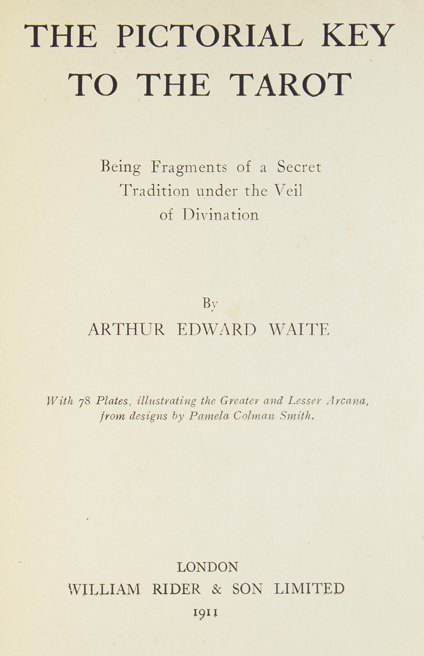The Key to the Tarot
The Key to the Tarot, later released as The Pictorial Key to the Tarot, is a divinatory Tarot guide, with text by A.E. Waite and illustrations by Pamela Colman Smith.
The book was first published in conjunction with the Rider–Waite Tarot deck, but without illustrations. The pictorial version (released 1910, dated 1911) was published following the success of the deck. Both Waite and Smith were members of the Hermetic Order of the Golden Dawn and relied on the organizations texts in creating the illustrations and meanings. Waite was very concerned with the accuracy of the symbols used for the deck, and he did much research into the traditions, interpretations, and history behind the cards.
Content
- Part I - "The Veil and Its Symbols": a short overview of the traditional symbols associated with each card, followed by a history of the Tarot. Waite dismissed as baseless the belief that the Tarot was Egyptian in origin, and noted that no evidence of the cards exists prior to the 15th century.
- Part II - "The Doctrine of the Veil": contains 78 black and white plates of Smith's illustrations for the Rider–Waite deck, and a discussion of the unique symbols chosen for each card. Waite drew upon the earlier Tarot of French occultist Eliphas Levi, at times retaining his changes to the traditional deck (as with The Chariot card, which both Waite and Levi picture being drawn by two sphinx, instead of horses), at other times criticizing him (as with The Hermit card, which Waite thought Levi misinterpreted).
- Part III - "The Outer Methods of the Oracles" - concerns matters of divination with the cards, including a description of the popular Celtic Cross Tarot layout, which the book helped bring to prominence.
Legacy
In 1918, American author L. W. de Laurence published an exact facsimile copy of the book under the title The Illustrated Key to the Tarot: The Veil of Divination, Illustrating the Greater and Lesser Arcana without giving any credit to Waite.
